How selective Russian targeting effectively blockaded Ukraine’s Black Sea grain exports
Evidence from the Odesa region shows retaliatory Russian strikes destroyed harbor infrastructure, silos, and industrial farms
How selective Russian targeting effectively blockaded Ukraine’s Black Sea grain exports
Share this story
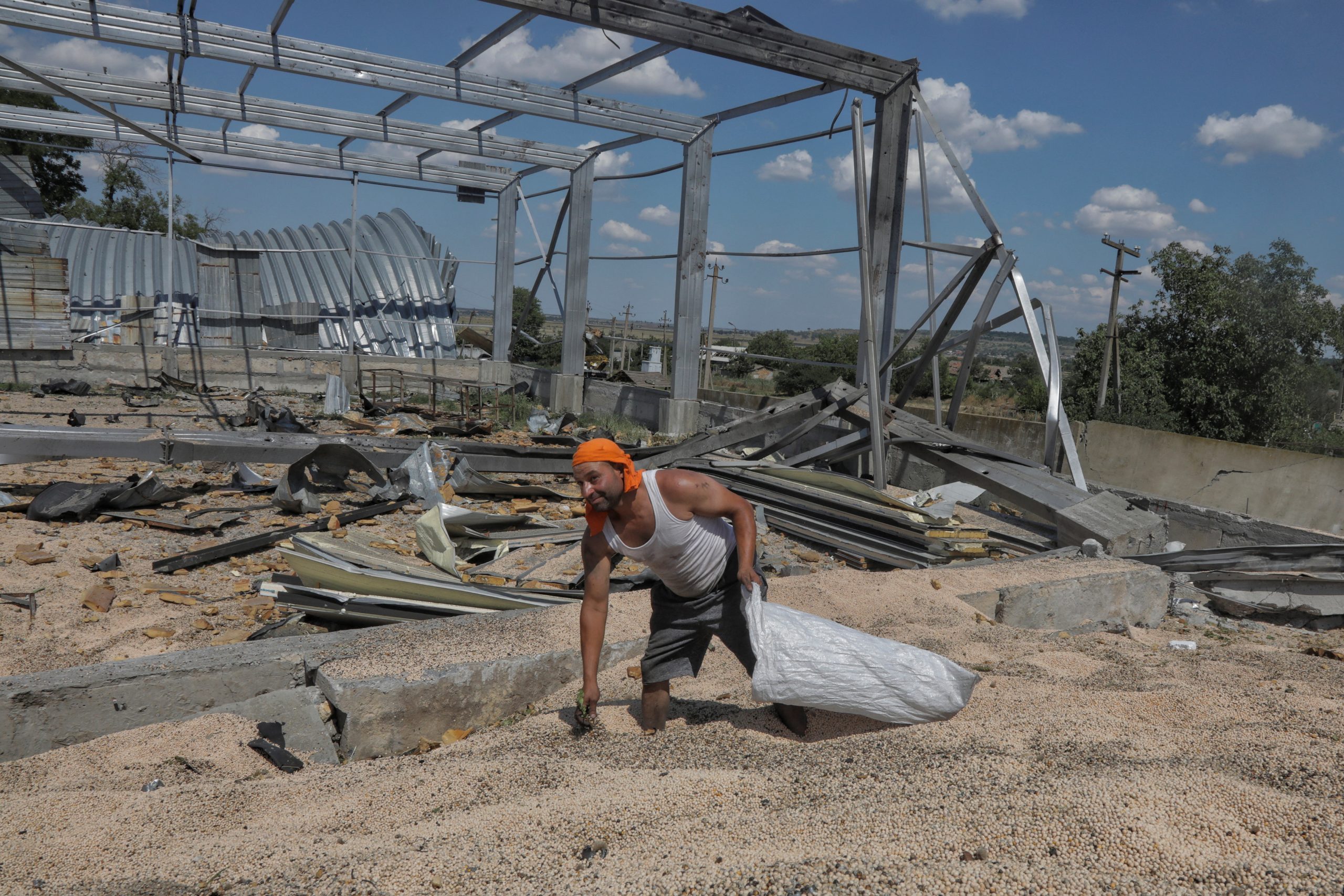
BANNER: An employee grabs pea into a bag at a grain warehouse destroyed by a Russian missile strike in the village of Pavlivka, Odesa region, Ukraine, July 21, 2023. (Source: Reuters/Nina Liashonok)
Between July 18 and July 24, 2023, Russia selectively targeted critical Ukrainian port infrastructure on the Black Sea coast and the Danube River. Combined with Russia’s July 17 withdrawal from the Black Sea grain deal, this effectively resulted in a blockade on Ukraine’s ability to export grain. The DFRLab collected evidence from Ukraine’s Odesa region documenting the destruction of harbor infrastructure, silos, and industrial farms. Using geolocation and footage verification, the DFRLab identified the missiles and drones Russia used to strike these locations.
On July 17, 2023, Ukraine struck the Kerch Strait Bridge, marking the second strike on the bridge since Russia invaded Ukraine on February 24, 2022. The bridge serves as one of Russia’s only supply routes to occupied Crimean territory, via the Rostov region, which makes it a critical infrastructure route for Russian armed forces. In what appear to be further efforts to disrupt Russian supply routes to Crimea, Ukraine on August 7 struck two bridges near Chonhar, which connects the Crimean Peninsula to the Russian-occupied region of Kherson.
Shortly after news of the attack against the Kerch Bridge emerged, Russian officials announced Russia’s intention to pull out from the Black Sea Grain Initiative, an agreement between Ukraine and Russia brokered by the United Nations and Turkey that guarantees Ukrainian grain exports via Black Sea ports. The deal was established to prevent a global food crisis in the spring of 2022, which would have particularly impacted the Middle East and North Africa as these countries are considerably dependent on Ukrainian grain imports. Additionally, Russia declared that starting July 20, 2023, it would consider any vessel operating within Ukrainian maritime territory in the Black Sea as a potential military target.
In the early hours of July 18, footage posted on Telegram by the pro-Russian account Colonelcassad suggested that Russian armed forces had retaliated by conducting missile launches, drone attacks, and air raids against Ukraine’s port in the Odesa region and the surrounding area. The large-scale attack struck the harbor cities of Odesa, Chornomorsk, and Mykolaiv. The Russian defense ministry justified the attacks as a means to deter the construction of an arsenal that would enable Ukraine to launch “terrorist attacks” against Russian infrastructure. Russian opposition media outlet Mediazona qualified the June 18 attack as the “most massive attack since the beginning of the war.” The attack also severely damaged Odesa’s Transfiguration Cathedral.
Kremlin spokesperson Dmitry Peskov confirmed the July 18 attack was “retribution” (“возмездие”) for the partial destruction of the Kerch Bridge, according to Ukrainian online newspaper Ukrainska Pravda. Russian President Vladimir Putin previous utilized this narrative in October 2022 when he accused Ukrainian special services of perpetrating the first attack against the Kerch Bridge, thereby justifying the destruction of commercial and civilian infrastructure in retaliation.
The June 18 attack was followed by further targeting of Ukrainian port infrastructure in early September 2023. According to Ukrainian online outlet ZN, Russian forces attacked Odessa on September 13 for four and a half hours and used at least thirty Shahed-136 drones. The attack reportedly also struck the Sumy region.
Russia strikes Ukrainian port infrastructure after pulling out of grain deal
After the July 17 attack on the Kerch Bridge, the Russian Ministry of Defense (MoD) set out to destroy the harbor infrastructure used to produce and export grain in Ukraine’s Odesa region. Cascading Russian attacks resulted in the destruction of industrial farms, silos, and grain terminal equipment. Geolocation and verification of footage shows that Russia targeted port infrastructure and oil depots, resulting in fires that destroyed silos and fields near Mykolaiv, hindering Ukraine’s overall grain export capacity.
On July 19, reports emerged of an attack against the port of Chornomorsk, one of the region’s largest grain terminals, located south of Odesa. Ukraine’s Minister of Agrarian Policy and Food Mykola Solskyi declared that Russia destroyed nearly 60,000 tons of grain, whose delivery had already been delayed by sixty days. Footage posted on Telegram by Russian military blogger RusVesna shows a fire in the Chornomorsk port inflicted damage to a crane operating in the grain terminal. The Ukrainian Agrarian and Food Ministry posted a picture of a destroyed grain silo on their website; the DFRLab uncovered the location using Planet.com satellite imagery. The map below shows burn marks where the fire broke out, as well as the destroyed silo.

A separate Russian attack on the night of July 18 struck an oil depot in Mykolaiv’s harbor. The DFRLab collected satellite imagery of the oil depot, which is located in an industrial plant. According to a photograph shared by Ukraine’s Emergency Service, the attack set fire to a nearby wheat field. The plant does not appear to have participated in manufacturing naval drones, nor does it appear to belong to Ukraine’s military-industrial complex.
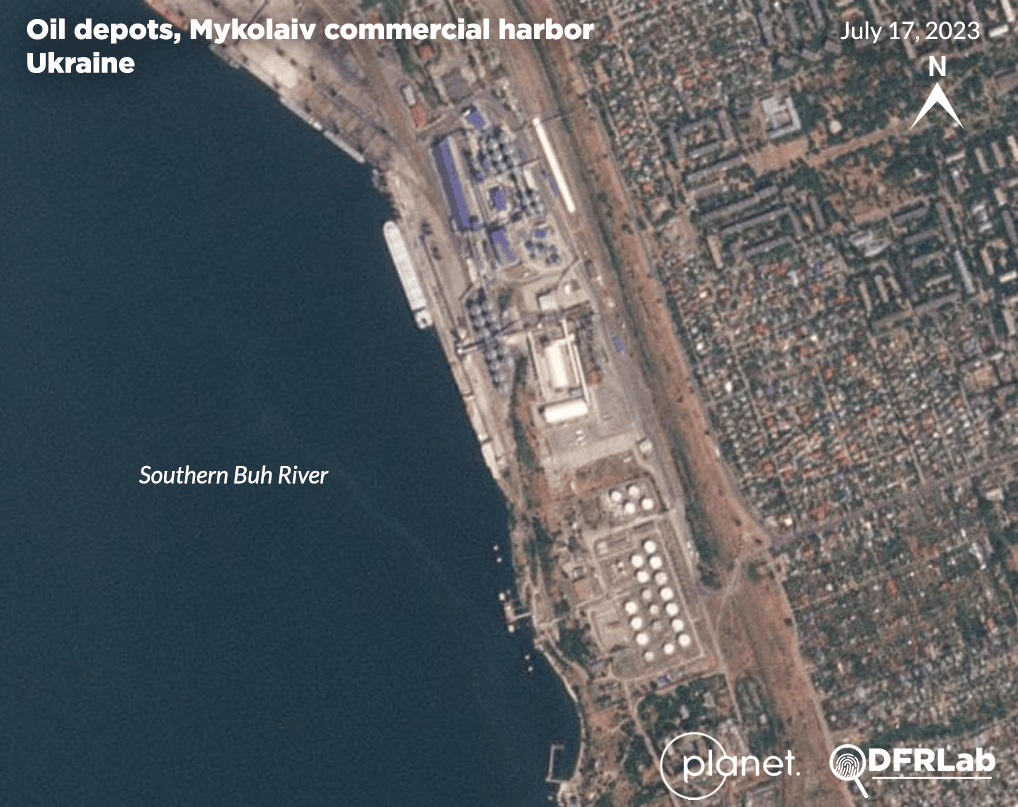
Further destruction was observed after a July 20 attack on an industrial farm near the village of Pavlivka in the Odesa region. By verifying satellite imagery from Planet.com, the DFRLab confirmed the location of the attack and established that damage was inflicted to one of the industrial farm’s storage hangars. The farm is fifty kilometers from Ukraine’s shore and one hundred kilometers southwest of Chornomorsk harbor, indicating Russia conducted a strike deep inside Ukraine’s grain production industry.
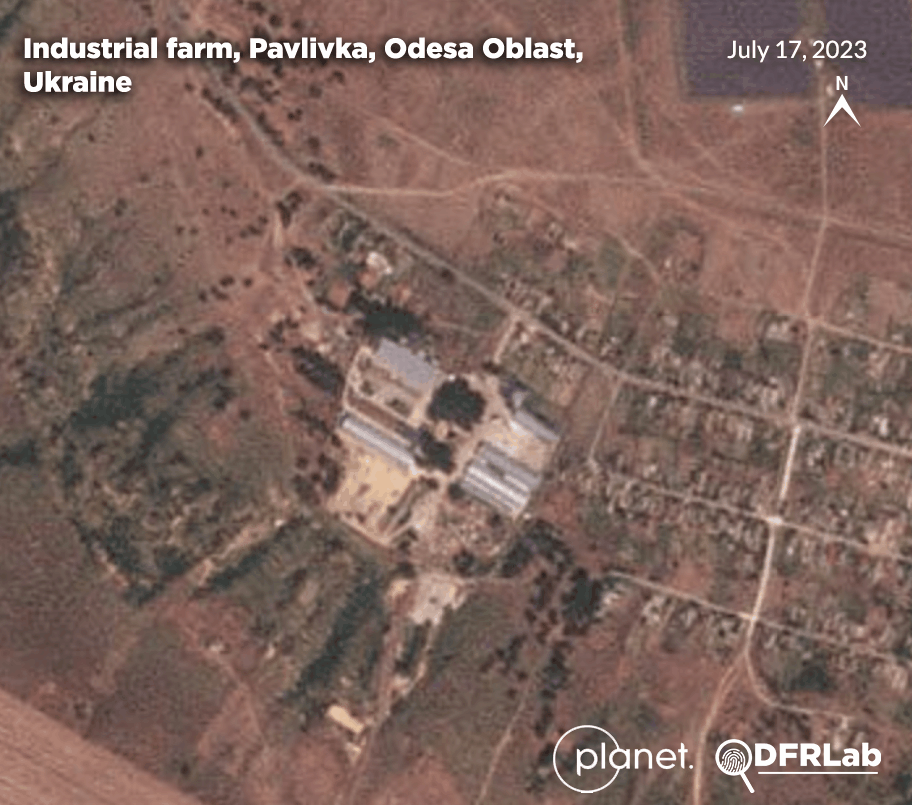
Additionally, footage posted on Telegram by the Ukrainian channel Odesa Now: News reported the presence of a naval mine near Chornomorka beach in Odesa. The DFRLab geolocated the footage to determine where the mine reportedly washed ashore. The location notably appears to be five kilometers north of Chornomorsk harbor. Following the attack, the US National Security Council expressed concerns over the laying of mines in the Black Sea by the Russian Navy, according to the US Naval Institute’s news website. This highlights the difficulty of navigating the Black Sea during and after the large-scale attacks against Odesa Oblast in late July.
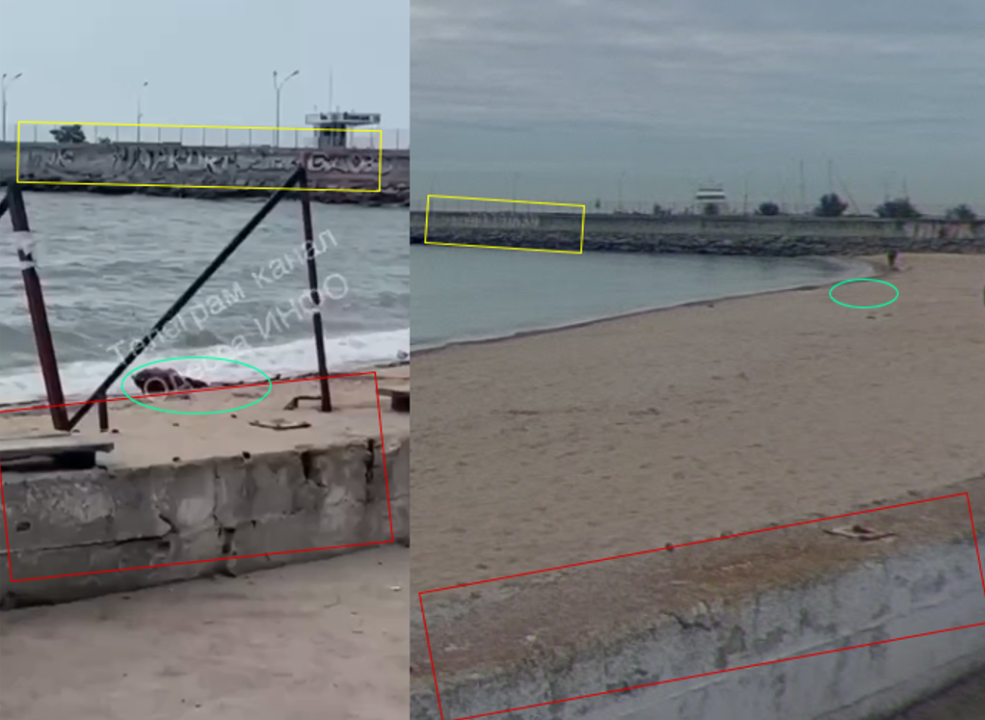
Possible attempts to avoid Ukrainian air defense systems
In a July 18 Telegram post, the Russian MoD stated that it utilized “high precision weapons” against the Odesa region. However, footage posted by Ukraine’s Emergency Service and various Telegram channels suggests that Russia used Shahed drones and Kalibr missiles in the attack. The DFRLab verified and analyzed the footage and concluded that the Russian MoD conducted a larger scale attack than it acknowledged.
Debris collected near an Odesa beach seems to indicate that the drones used in the July 18 attack were Shahed-136 drones, known in Russia as the Geran-2. Reviewing footage posted by the Ukrainian Border Patrol of the Odesa region following the June 18 attack, the DFRLab identified a piece of debris that strongly resembles a Madon MD-550 engine. The Conflict Armament Research initiative established in an April 2023 publication that Iranian-made Shahed-136 drones are powered by MD 550 engines.
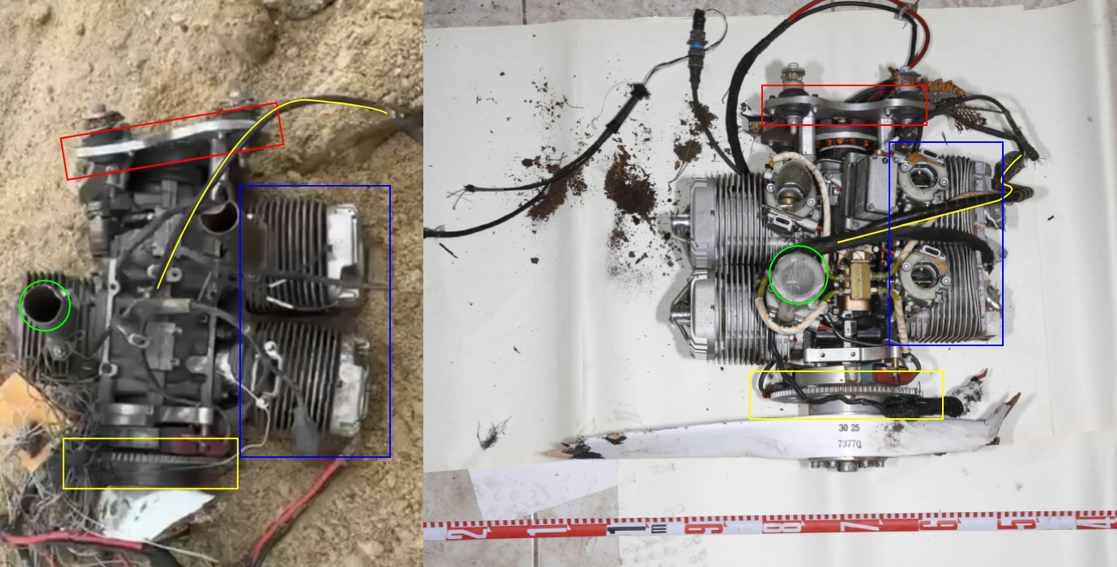
Other debris collected by local residents suggested the July 18 attack also struck residential areas; this may further indicate the missiles used in the attack were not “high precision weapons.” In addition, footage from a Ukrainian police officer’s body camera posted on Telegram on July 18 appears to show police rescuing a civilian couple whose home was reportedly struck by a Russian missile. The footage also shows a hole in the roof of the struck house. Another video shows a crane removing rocket debris from the inside of the house. The footage was originally posted by the Ukrainian media outlet Suspilne and was later reposted on the Telegram channel Odesa Now: News.
Based on this footage and an early assessment of Ukrainian media, the DFRLab used visual confirmation to conclude that the missile is likely a Kalibr ZP-14 family cruise missile (3П-14 in Russian). The comparisons below show similar fins, bolt organization, markings, and an identification number consistent with the inscription “3П-14.”
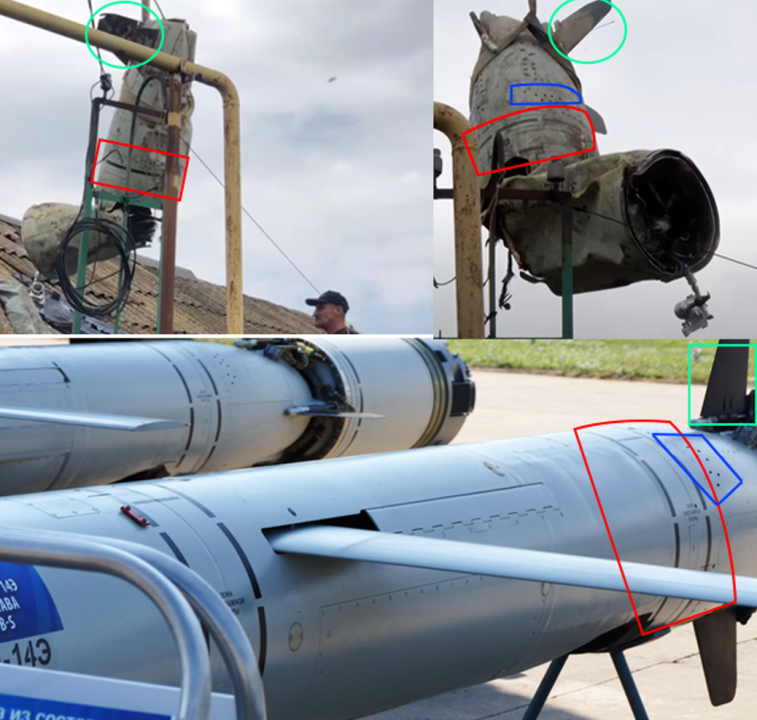
Upon analyzing the missile’s serial codes, the DFRLab uncovered that the missile is highly likely to be a ZP-14 Kalibr missile. Notably, Russia reportedly used these missiles in an attack on the Vinnytsia region conducted on June 23, 2022. Footage posted of that attack showed markings very similar to those present in the July 2023 video of missile debris in the Odesa region.
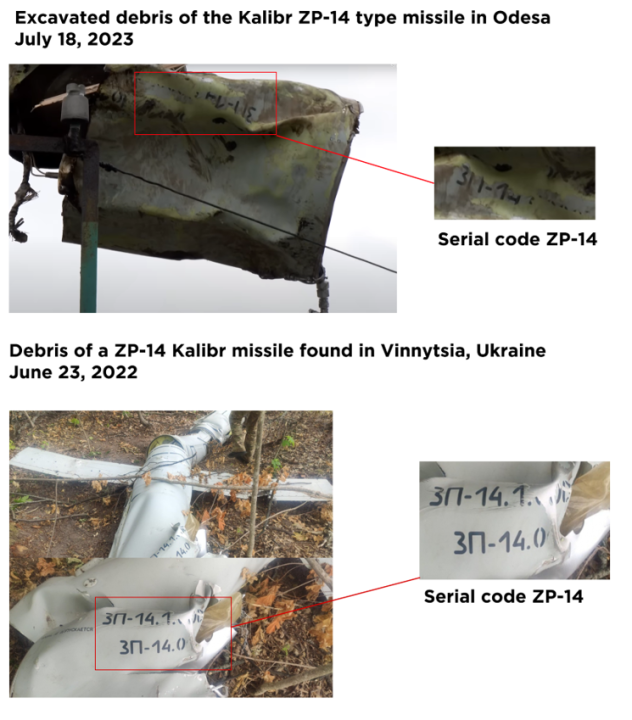
Additionally, according to an assessment by Ukrainian military expert Pavlo Lakiychuk cited by Radio Free Europe/Radio Liberty, the Russian armed forces utilize both drones and surface missiles to avoid and distract Ukraine’s anti-air defense systems. The DFRLab can infer that a similar type of coordinated attack with both drones and cruise missiles likely occurred between July 18 and July 24.
Russia strikes Ukraine’s alternative export harbor
Following Russia’s declaration that it would consider any vessel operating in Ukrainian Black Sea maritime space as a potential military target, BBC Ukraine Correspondent James Waterhouse noticed that dozens of ships were stuck at the estuary of the Danube River, the only remaining export harbor no longer in Ukraine’s maritime space in the Black Sea.
As of August 11, 2023, Marine Traffic data showed a high concentration of general cargo ships and bulk carriers dedicated to the export of grain in Masura Bay, where Romanian and Ukrainian river ports on the Danube have become the primary alternative route.
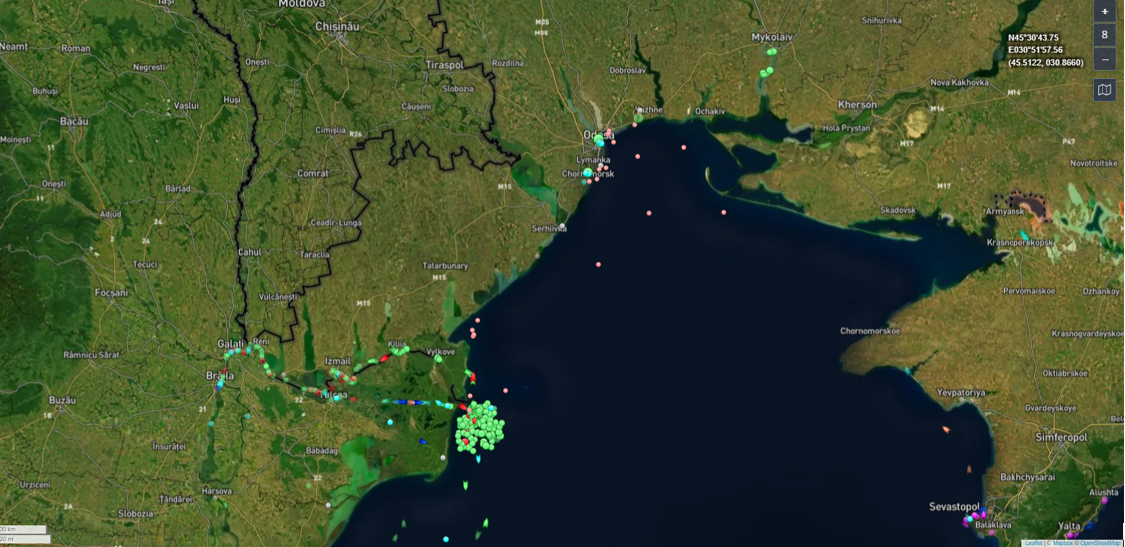
On July 23, Russia reportedly conducted another attack that struck silos in Ukraine’s Reni harbor, on the left bank of the Danube River and the border of Moldova. The DFRLab analyzed satellite imagery to confirm the location of the attack and document the subsequent destruction of another grain silo.
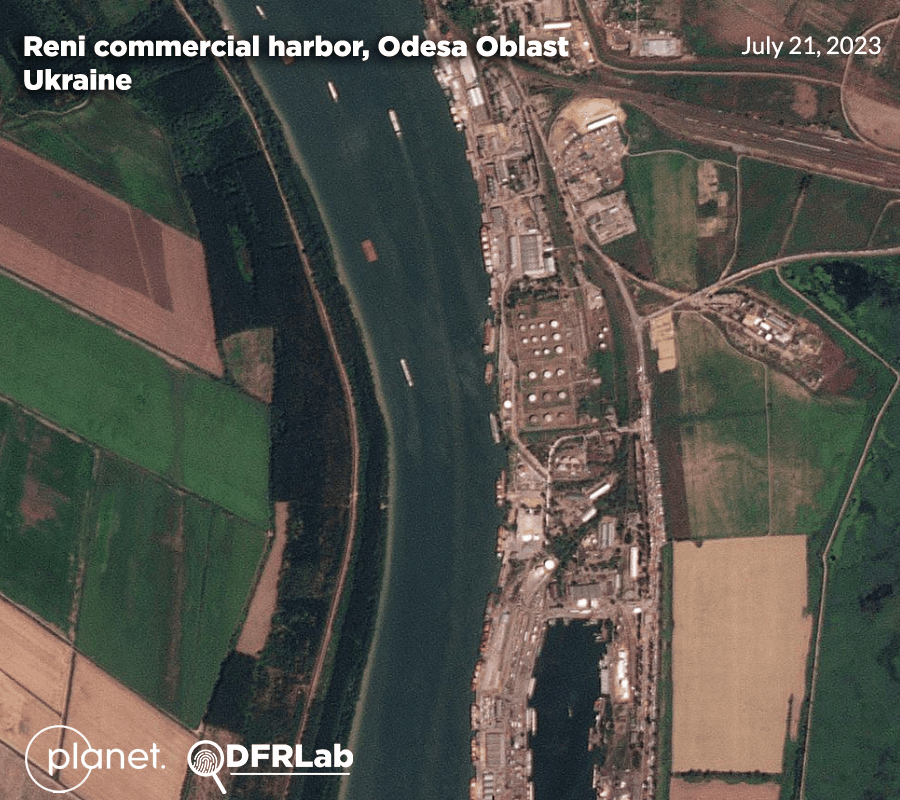
By pulling out of the grain deal, attacking grain ports in the Black Sea, and escalating the likelihood of strikes against vessels in the Black Sea, Russia has effectively created a new grain blockade preventing Ukrainian grain from leaving its coastal ports. The partial destruction of the Kerch Bridge, while likely part of a broader Ukrainian strategy focusing on Russian bases in Crimea, triggered Moscow to respond both diplomatically, in exiting the grain deal, and violently, in launching a series of attacks against Ukrainian grain infrastructure. Russia’s two-fold strategy appeared to be damaging Ukraine’s harbors and inland infrastructure while blockading cargo ships from Ukraine’s maritime territory. As illustrated by its raid on a civilian dry cargo ship on August 13, Russia sought to create an atmosphere of danger and unreliability when it comes to navigating the Black Sea. Although European efforts to export grain may ultimately provide a sustainable alternative route for Ukrainian grain, the security situation in the Black Sea remains highly escalatory.
Cite this case study:
Valentin Châtelet, “Russia retaliates against July Kerch Bridge attack by effectively blockading Ukraine’s Black Sea grain exports,” Digital Forensic Research Lab (DFRLab), October 4, 2023, https://dfrlab.org/2023/10/04/how-selective-russian-targeting-effectively-blockaded-ukraines-black-sea-grain-exports.

